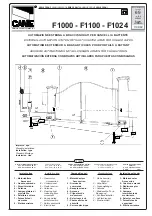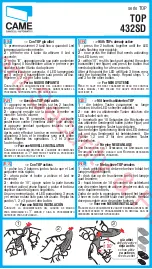
SPEEDGATE Installation and Maintenance Manual
Revision 1 - MAY 2023
29
EXTERNAL ENTRAPMENT PROTECTION SENSORS
External Entrapment Protection Sensors
The SpeedGate is equipped with a Type A inherent entrapment sensor (IES) which is a reduced speed
sensor/torque change sensor, as described in “Inherent Entrapment Sensor” on page 26. The IES is an
internal device built into the SpeedGate operator.
UL 325 Safety Standard compliance requires installation of external entrapment protection sensors, the
number of which, depends on the entrapment hazards that exist at each particular installation.
To comply with UL 325, the following external sensors may be used:
•
Contact sensors, such as edge sensors
•
Non-contact sensors, such as photoelectric eyes
The site designer or installer can choose either photoelectric eyes or edge sensors or use these devices in
combination. Whatever devices are used, protection in both the opening and closing directions of gate
travel must be provided.
The UL 325 Safety Standard specifically requires that edge sensors or photoelectric eyes or a combination
of both devices be installed to protect against pedestrian entrapment in BOTH directions of the gate travel
and where an entrapment hazard exists.
PHOTOELECTRIC EYES:
One or more photoelectric eyes shall be located where the risk of entrapment
or obstruction exists, such as the perimeter reachable by a moving gate. Refer to “Figure 2. SpeedGate
Common Entrapment Zones” on page 33.
EDGE SENSORS:
One or more edge sensors shall be located on the inner and outer leading edge of a swing
gate where the risk of entrapment or obstruction exists. If the bottom edge of the swing gate is situated
more than 6 inches (152 mm) above ground level at any point in its arc of travel, one or more contact
sensors must be located on the bottom edge, as well.
SENSOR SECURITY:
A hard -wired sensor shall be located and its wiring arranged so that communication
between the sensor and gate is not subjected to mechanical damage.
SENSOR FUNCTION and COMMUNICATION:
A sensor that transmits its signal to the gate system must
be located so its signal is not impeded by building structures or other obstructions. All sensors must be
installed so that they function as intended for the end-use conditions.
A photoelectric eye or contact sensor is
also required to protect against possible
entrapment if the gate opens to a
position less than 16 inches (40.6cm)
from any object, such as a post or wall.
Содержание SPEEDGATE
Страница 48: ...48 wallaceperimetersecurity com Phone 866 300 1110 SPEEDGATE INSTALLATION...
Страница 52: ...52 wallaceperimetersecurity com Phone 866 300 1110 SPEEDGATE INSTALLATION...
Страница 59: ...PDXT PDXT C and PDTT Electrical Point to Point Diagrams 1...
Страница 60: ......
Страница 61: ...PDXT PDXT C and PDTT Electrical Point to Point Diagrams 2...
Страница 62: ......
Страница 63: ...PDXT PDXT C and PDTT Electrical Point to Point Diagrams 3...
Страница 64: ......
Страница 102: ......
Страница 103: ......
Страница 104: ......
Страница 105: ......
Страница 106: ......
Страница 107: ......
Страница 108: ......
Страница 109: ......
Страница 110: ......
Страница 111: ......
Страница 141: ......
Страница 142: ...115 Lowson Crescent Winnipeg Manitoba Canada R3P 1A6 Phone 866 300 1110 wallaceperimetersecurity com...
















































